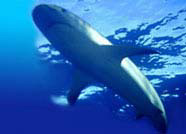


Shark Reproduction

 |
 |
 |
|||
| Home | Evolution
| Classification
| Glossary | Biology
| Behavior | Shark
Repellent | Shark
Conservation | Do's &
Don'ts | Did You Know?
Shark Reproduction |
 |
||||
|
Baby sharks receive little or no parental care when they enter their
perilous underwater world, so shark mothers ensure they receive a good
start in life before they are born. Unlike some bony fish that produce
millions of eggs and larvae that are left to the mercy of the sea, sharks
produce relatively few eggs and embryos (in most species less than 100)
and protect them well. They do so in one of two ways: by protecting
their embryos within egg cases that are deposited somewhere safe; or
by retaining their embryos inside the body.
The more primitive system is oviparity, meaning 'born from an egg', which is adopted by the dogfish, the nursehound, the swell shark and the Port Jackson shark. Each of their eggs is enclosed in a tough capsule known as a 'mermaid's purse.' Other species are viviparous, meaning 'live birth'. The embryos develop in the uterus (a shark's uterus is divided into two branches), and obtain their nourishment directly or indirectly from their mother. A hammerhead shark embryo, for example, relies on a yolk sac for food at first but later the sac begins to grow branches that fasten to the uterine wall, like a placenta, and extract nutrients directly from the mother's blood system. The most bizarre form of viviparity must be that of the sand tiger shark. When the embryos have used up their yolk sac they take to eating each other. Two dominant babies eventually survive, one in each uterus, and they are fed yolk-rich unfertilized eggs until the two intra-uterine cannibals are born. Courtship and Mating At some point in their lives, sharks must meet to procreate. Courtship and mating behavior is rarely observed in the wild, but it is thought receptive females release pheromones (natural chemical stimulants) into the water to attract males. At Cocos Island, in the eastern Pacific, female whitetip reef sharks have been seen pursued by gangs of eager males. At Cape Hatteras, on the US Atlantic coast, sand tiger sharks are a little more reserved. They gather in groups of five or six, each shark stacked one on top of another. Both males and females hang motionless in the water until the time comes for them to mate. Mating in sharks can be a violent affair. The male grabs a female by her pectoral fin or the skin behind her head and hangs on tightly. The female's skin is thicker than the male's (in some cases as much as three times as thick) so he inflicts less damage. Once he is firmly attached, and the other males have drifted away, he introduces his sperm into her cloaca using one of a pair of sausage-shaped claspers, each a penis-like extension of the pelvic fin. A spur or a bank of terminal ridges at the tip prevents it from slipping out. The sperm is then transferred in a jet of seawater squirted out by a pair of muscular-walled siphon sacs in the male's abdominal wall. Mating complete, male and female part company. |
|
||||||||||
| Sitemap | Reach To Us | Jimtrade - Business Directory of India | |||||||||||